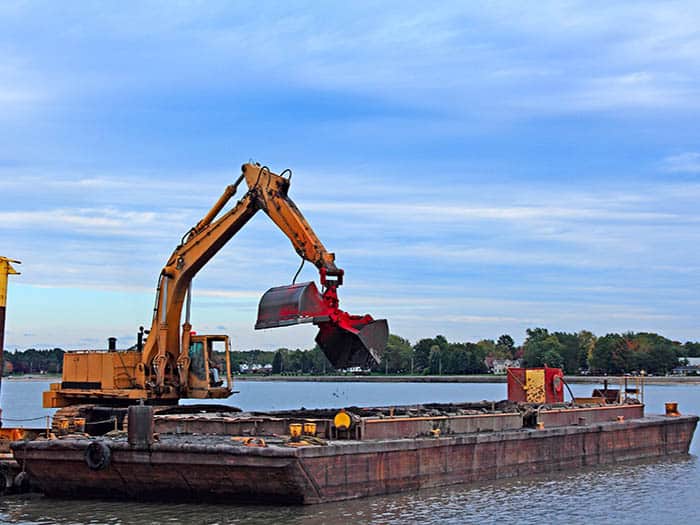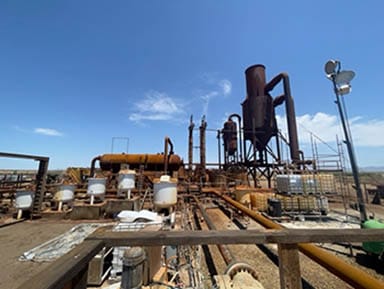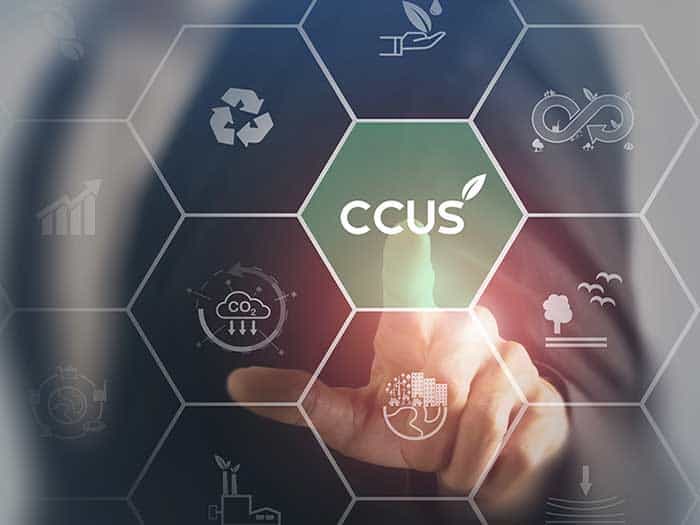

The South Carolina Chapter of SWANA is hosting its biannual Region 6 Conference and Trade Show at the Hyatt Regency in beautiful downtown Greenville, SC, August 29 – September 1.
Formerly known as “Quad State,” this conference brings together SWANA representatives from Virginia, Kentucky, Tennessee, North Carolina, and South Carolina to present on the latest solid waste topics in the region.
SC SWANA Chapter President, SCS’s own J Morgan, PE, and the planning committee are preparing an engaging agenda of technical sessions, excellent networking opportunities, and a trade show.
SCS experts are presenting at the conference sessions – more details to come!
Click for more conference details and registration information.
See you there!

In degraded ecosystems, manipulating sediments can aid in recreating natural sediment processes, establishing suitable substrate conditions for aquatic life, and supporting the recovery of vegetation and wildlife. In the United States, sediment management revolves around the presence of contaminated sediment. Contaminated sediment sites pose intricate technical challenges that demand significant resources to address and mitigate the associated problems effectively.
Over the past three decades, significant progress has reduced the discharge of toxic and persistent chemicals into waterways throughout the United States. However, a persistent problem remains, characterized by elevated concentrations of contaminants in the sediment found at the bottom of rivers and harbors. The situation has raised considerable concerns about its potential risks to aquatic organisms, wildlife, and humans.
This paper delves into the technical challenges environmental engineers and consultants face in addressing and mitigating this issue, especially during waterfront remediation projects. Furthermore, he explores strategies to optimize resources to tackle the problem at hand effectively and efficiently.
Active monitoring and data collection is critical throughout the remediation process. These activities enable evaluating the chosen strategy’s effectiveness, identifying necessary adjustments, and ensuring compliance with environmental regulations. Adaptive management approaches allow modifying or refining the sediment remediation strategy based on monitoring results and stakeholder feedback.
The utmost importance lies in choosing the appropriate remediation techniques; base the decision on site conditions, the specific contaminants present, and the desired remediation goals. After reading the paper, you may get a better idea of the options available for achieving effective and sustainable sediment remediation outcomes.


Early one Saturday morning, SCSers Chuck Houser, Luke Montague, Allison O’Neal, and me, Jen Morton, headed out to Brawley in the Imperial Valley region of Southern California. That is the desert. We had been having our usual May Gray here in SoCal when the summer can feel like winter at the coast, but the desert was a balmy 100 degrees and sunny that day.
We met with Sean Wilcock of the Imperial Valley Economic Development Corporation, one of our clients for Brownfields work, at a coffee shop in Brawley. From there, we ventured north to an area between Calipatria and Niland to see the beginning workings of a lithium extraction operation.
This region lies at the southern end of the San Andreas fault, where the motion between the North American and Pacific Plates begins to switch from strike-slip to extensional or from side-by-side to pulling apart. Where extension occurs, the crust tends to be relatively thin. Imagine pulling apart a sticky bun or taffy – the middle starts to get thinner before it breaks.
With the thinning of the crust, hot magma from the earth’s interior is closer to the surface. The heat from the magma heats the groundwater, which is A LOT beneath the Imperial Valley. And in this groundwater are minerals that, until recently, have not necessarily been worth the effort to extract from the water.
For decades energy companies have been using this super-heated water to generate electricity in the Imperial Valley. The hot water is pumped up from deep within the earth, using the steam to rotate turbines. The water is then pumped back into the aquifer.
Before our trip, Chuck and I met Tracy Sizemore, director of Battery Operations for Controlled Thermal Resources (CTR), at a San Diego Association of Geologists (SDAG) meeting learning more about the mineral resources in Imperial Valley. Chuck and I were as fascinated with that as the opportunity to see the biggest drill rig we’ve ever seen, which would be drilling an 8,000-foot well for groundwater extraction. We learned about the brine’s lithium resources (another term for the super-heated, mineral-rich groundwater).
Lithium has become a highly sought-after metal with the proliferation of electric vehicles. Given this increase in value, it is now economically feasible to extract it from the brine as part of the energy generation process. Some companies have plans to conduct the extraction in addition to electricity generation at existing geothermal plants. One company will build a separate extraction facility next to an existing plant.

CTR is planning to develop a plant that will focus primarily on the extraction of lithium, with energy generation being secondary. As Geologists, we got a tour of CTR’s prototype plant. It was fascinating to see all of the equipment and the results of the extraction process – a small bottle of lithium-rich liquid worth about $10. The extraction process also creates a sludge containing other important elements, including manganese, zinc, and even gold and silver. The plan is to sell the sludge to another company to extract the additional economic elements.
The process of extracting lithium in this manner is sustainable and much cleaner than traditional mining methods. It is also considered carbon-neutral. The new plant will generate enough electricity to power it 100%, with enough left over to power a battery manufacturing facility next door after its construction.
CTR’s lithium extraction process expects to bring 1,400 jobs to the area, with another 4,000 jobs once the battery plant is up and running. With the influx of workers, the Imperial Valley needs more infrastructure, housing, and services, so it is supporting economic growth.
In the fall, we plan to return to CTR’s facility to see the enormous rig drilling the 8,000-foot well!
Meet the Author – Jen Morton, Professional Geologist and SCS Project Manager
Consider a position with the finest pure-environmental firm in North America!
Meet SCS Engineers’ solid waste waste experts at BOOTH 502 at WASTECON 2023, SWANA’s executive leadership summit, taking place September 27–29, in Boston, MA.
This is a must-attend event for anyone who seeks to remain at the forefront of the solid waste industry and maximize their organization’s potential for success.
Register by July 31 to take advantage of early bird pricing. Click for more conference details
Join SCS Engineers solid waste experts Michelle Leonard and Tom Parker at the New Mexico Recycling & Solid Waste Conference, September 19-20, at the Sheraton Albuquerque Uptown.
The conference, titled The Value of Materials & Relationships, is jointly Hosted by The New Mexico Recycling Coalition & New Mexico SWANA Roadrunner Chapter. It will feature speakers, plenary session, networking opportunities and more focusing on hot topics in solid waste industry.
For more conference details and registration information, click here.
Hope to see you there!
SCS Engineers is attending both of the University of California’s Fall Recruiting Opportunities on September 6 at the USC Michelson Center. We will be at the Diversity Meet and Greet from 2:00 pm to 4:30 pm and at the Veterans and Military Families Recruiting Night from 5:30 pm to 7:30 pm.
The Diversity Meet & Greet (DMG) is held each fall semester. Employers with strong diversity initiatives network with students from historically underrepresented populations. This year, employers will engage with students in panel discussions held in the affinity spaces. Registration for students will open in August on connectSC.
The Veterans and Military Families Recruiting Night is a campus-wide partnership between the Office of the Provost, Student Veterans Association, Marshall Master of Business for Veterans, Alumni Veterans Network, and the Veterans Resource Center, and is open to all veteran students, alumni, veteran community members, and their spouses/families from multiple universities. Register via connectSC.
We hope to meet you there!

On June 12, 2023, the Maryland Department of the Environment (MDE) published its final regulation addressing the control of landfill gas (LFG) methane emissions from municipal solid waste (MSW) landfills in the state (promulgated under COMAR 26.11.42). Methane is a potent greenhouse gas (GHG) with a global warming potential more than 25 times greater than carbon dioxide. The rule has been several years in the making and is modeled after similar rules in California and Oregon. The rule also incorporates provisions from the EPA’s federal landfill air regulations under NSPS & EG 40 CFR 60 Subparts Cf and XXX and NESHAP CFR 63 Subpart AAAA and stands among the most stringent in the US.
The new regulation will be submitted to the EPA for approval as part of Maryland’s state plan for MSW landfills (state plan). The state plan will be equivalent to or more stringent than the EPA’s NSPS & EG 40 CFR 60 Subparts Cf and XXX and NESHAP CFR 63 Subpart AAAA and will apply to smaller and mid-sized landfills not currently subject to the EPA’s federal rules. MDE estimates that 32 active and closed MSW landfills in the state will be subject to the rule. The rule is effective June 12, 2023.
Some key provisions of the rule include:
This rulemaking has been several years in development and is consistent with Maryland’s GHG Reduction Act of 2009 and the recent Climate Solutions Now Act of 2022 that requires Maryland to become “net zero” for GHG emissions by 2045, with an interim goal of achieving 60% GHG reductions by 2031 (over 2006 levels). MDE estimates this rule will achieve a 25-50% reduction in GHG emissions from affected landfills.
Additional information on MSW regulations and GHG emission reductions:

Dr. Hostetler will present “A Computational Modeling Approach to Critical Pressure Calculations for Class VI Area of Review Delineation” [Thursday, September 14, 10:30 – Noon, Session Class VI UIC] at the Groundwater Protection Council 2023 Annual Forum in Tampa.
Presentation Category: Carbon Capture and Underground Storage
Subsurface pressure increases as supercritical carbon dioxide is injected into a deep saline reservoir beneath a confining zone. If the pressure buildup is great enough, brine could be lifted upward from the injection zone through an inadequately plugged or abandoned well that penetrates the confining zone. This could result in the endangerment of an underground source of drinking water (USDW). A Class VI Injection Permit requires a delineation of the Area of Review (AoR). The AoR is the superposition of the area of the buoyant supercritical plume itself, together with the area over which the pressure front is large enough to potentially endanger a USDW through some conduit. The USEPA Class VI Guidance offers several approaches to calculating critical pressure. Some of these methods are based on concepts of changes in potential energy in artificial penetration and are very easy to implement. Unfortunately, they are simplified models and are also very conservative. The USEPA Guidance also allows for the computation of the critical pressure by computational modeling. We present a computational modeling approach that is more mechanistic, explicitly addresses uncertainty, can be updated as additional testing and monitoring data become available, and provides a more authentic representation of the critical pressure and hence, the AoR.
 Dr. Hostetler has nearly four decades of experience as a geochemist and hydrogeologist. His expertise focuses on subsurface multiphase flow modeling, groundwater flow and transport modeling, and reactive solute transport modeling. Dr. Hostetler is an SCS Engineer’s Deep Well Initiative and Class VI Permit Team member. Charles Hostetler has a BS in Geosciences and a Ph.D. in Planetary Sciences from the University of Arizona.
Dr. Hostetler has nearly four decades of experience as a geochemist and hydrogeologist. His expertise focuses on subsurface multiphase flow modeling, groundwater flow and transport modeling, and reactive solute transport modeling. Dr. Hostetler is an SCS Engineer’s Deep Well Initiative and Class VI Permit Team member. Charles Hostetler has a BS in Geosciences and a Ph.D. in Planetary Sciences from the University of Arizona.
Find out more:

The Environmental Protection Agency (EPA) is proposing to designate perfluorooctanoic acid (PFOA) and perfluorooctanesulfonic acid (PFOS), including their salts and structural isomers, as hazardous substances. The proposed rule published in the Federal Register designates two per- and polyfluoroalkyl substances (collectively, PFAS) constituents as CERCLA Hazardous Substances. While this is a small subset of PFAS constituents, PFOA and PFOS are reportedly the most commonly used and likely to be detectable. Additional PFAS compounds are certainly on the horizon for consideration by EPA and, in fact, an Advance Notice of Proposed Rulemaking was issued by EPA in April of 2023 to seek input for seven additional compounds for hazardous substance designation.
What Could This Mean For Property Transactions and Real Estate Development?
When the CERCLA hazardous substance rule becomes final (anticipated in 2023 or 2024), it will be mandatory to consider these PFAS constituents when performing Phase I Environmental Site Assessments (ESAs) to identify Recognized Environmental Conditions (RECs) in connection with a property. Because of the ubiquitous use of PFAS, often called “forever chemicals,” in residential, commercial, and industrial products, some Environmental Professionals are concerned that PFAS-related RECs will be commonplace.
In their recent paper, “How Will EPA’S Proposed CERCLA Hazardous Substance Designation of PFOA and PFOS Impact the Environmental Due Diligence Practice?” Jeff Marshall, PE, and Mike Miller, CHMM, discuss the anticipated impacts of the PFAS rule on environmental due diligence. Depending on the former uses, the number of RECs, and ESA results, some sites are more likely to feel the impact on the potential value of a property.
As our PFAS knowledge continues to evolve, so will applying this knowledge to the environmental due diligence practice and, ultimately, real estate conditions. Read the technical paper to understand the terminology and types of properties more likely at risk.
 Jeffrey D. Marshall, PE – Vice-President. Mr. Marshall is a Vice President and the practice leader for the Environmental Services Practice for SCS offices in the mid-Atlantic region. He is also the SCS National Expert for Innovative Technologies and Emerging Contaminants. His diversified background is in project engineering and management, with an emphasis on the environmental chemistry and human health aspects of hazardous materials/waste management, site investigations, waste treatment, risk-based remediation and redevelopment, and environmental compliance/permitting issues. He has over 40 years of environmental experience and directs and manages environmental due diligence projects in the mid-Atlantic. He is a chemical engineer, Professional Engineer (VA, MD, WV, NC, and SC) and meets the credentials of an Environmental Professional.
Jeffrey D. Marshall, PE – Vice-President. Mr. Marshall is a Vice President and the practice leader for the Environmental Services Practice for SCS offices in the mid-Atlantic region. He is also the SCS National Expert for Innovative Technologies and Emerging Contaminants. His diversified background is in project engineering and management, with an emphasis on the environmental chemistry and human health aspects of hazardous materials/waste management, site investigations, waste treatment, risk-based remediation and redevelopment, and environmental compliance/permitting issues. He has over 40 years of environmental experience and directs and manages environmental due diligence projects in the mid-Atlantic. He is a chemical engineer, Professional Engineer (VA, MD, WV, NC, and SC) and meets the credentials of an Environmental Professional.
Michael J. Miller, CHMM – Vice President. Mr. Miller is a Vice President and the practice leader for the Environmental Services Practice for SCS offices in the Central region. He also serves as an SCS National Expert for Environmental Due Diligence. He supports firm operations throughout the United States related to Phase I and II Environmental Site Assessments and the completion of large portfolios and complex site assessments. A Certified Hazardous Materials Manager (CHMM) since 2009, Mike has more than 28 years of experience in environmental management and consulting with an extensive background in RCRA-related matters and industrial compliance, planning, and permitting.
Additional Real Estate Resources:

Charm Industrial’s (Charm) $53M deal with Frontier to voluntarily sequester bio-oil underground is an example of early market leadership for alternative subsurface deployment methods in the negative carbon emissions market. SCS was instrumental in developing the pilot programs, initial testing, and regulatory approvals allowing Charm to scale up its processes and deliver on this commitment.
This deal will remove 112,000 tons of carbon dioxide by 2030. Charm’s method involves converting excess organic material, like corn stover, into bio-oil and putting that oil into abandoned oil wells.
Carbon capture has been a focus for Frontier for some time now. Prior to this announcement, they partnered with early-stage startups to remove 9,000 tons of carbon. This landmark deal is a continuation of Frontier’s efforts to spark growth and bring attention to the industry and is one of the largest legally binding agreements to date. SCS is thrilled for Charm and Frontier and this huge step forward. See the recent CNBC news article below for more information on this deal and its carbon offset impact.